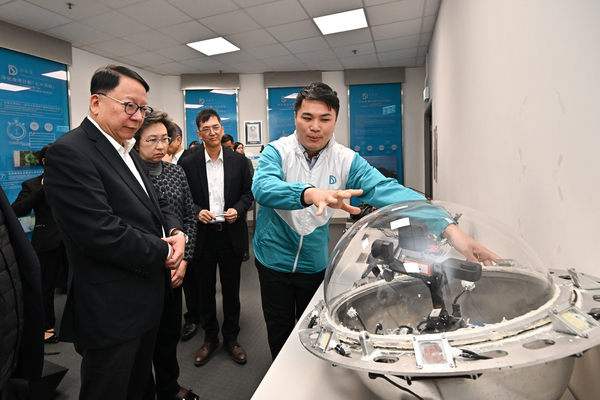CS updated on drainage works

Chief Secretary Chan Kwok-ki (first left) and Secretary for the Civil Service Ingrid Yeung (second left) are briefed on the use of an underground drainage inspection robot, "Tumbler Inspection Ball".
Chief Secretary Chan Kwok-ki and Secretary for the Civil Service Ingrid Yeung visited the Drainage Services Department (DSD) this afternoon to learn more about the department's daily operations and the progress of its drainage improvement works.
Mr Chan and other officials first met Director of Drainage Services Ringo Mok, together with directorate staff, and were briefed on the department's drainage improvement works in Hong Kong.
The department is carrying out seven drainage improvement works projects, covering Wong Tai Sin, Hong Kong Island East and other areas hit by severe floods in the past.
Besides adopting parallel tendering, the department is also striving to shorten the duration of engineering design, procurement and construction processes, in order to complete the improvements as soon as possible.
In response to the higher occurrence of extreme weather conditions in recent years, the department is committed to strengthening its Emergency Control Centre and emergency response teams, and to applying innovative technologies to enhance work safety and efficacy.
For instance, the deployment of a desilting robot, “River Ranger”, in emergency clearance works, is aimed at restoring communities to normality within the shortest period of time.
In addition, an underground drainage inspection robot known as “Tumbler Inspection Ball”, and other crawler-type survey robots, are used to conduct surveying works to determine the status of underground pipelines.
A “Tumbler Inspection Ball” robot can provide 360-degree all-round stable viewing, and then combine its 360-degree real-life images with artificial intelligence, helping officers to accurately check the status of pipelines.
In addition, the department's “Strategic Planning Study on Flood Management Against Sea Level Rise & Extreme Rainfall” will help it to formulate new and comprehensive city-wide flood management strategies.
Mr Chan said that in the face of various challenges brought about by climate change, the Government is dedicated to implementing a pre-emptive strategic approach and stepping up preventive and contingency measures on various fronts to protect lives and property.
He stressed that all government departments are working at full steam to scale up their handling capabilities to minimise the impacts of inclement or extreme weather conditions on the community, adding that the DSD plays a vital role in flood prevention and clearing blockages in drainage systems.
Mr Chan advised the DSD to prepare well for future rainy and tropical cyclone seasons by deploying adequate manpower and resources, stepping up inspections of drainage facilities, carrying out timely desilting work, ensuring the clearance of drainage channels across the city and disseminating information to the public properly.
He and Mrs Yeung encouraged DSD staff to stand fast at their posts, rise to the challenges ahead, maintain close communication with other relevant departments and organisations, and demonstrate professionalism and team spirit in order to be prepared for inclement or extreme weather conditions.
Mr Chan and other officials also toured the Stonecutters Island Sewage Treatment Works (SCISTW), largest of its type in Hong Kong.
They were briefed by staff on the DSD's work in taking forward sewage treatment initiatives such as the Harbour Area Treatment Scheme.
They also met duty officers at the Main Control Room of the SCISTW to learn more about the department's work in monitoring various sewage treatment processes around the clock, and about its contingency strategies in case of inclement or extreme weather conditions.
They then viewed the SCISTW from a green roof, where they were briefed on the sewage treatment facilities and the operation of facilities such as Clean Harbour 2, an advanced vessel for the transportation of sludge from the SCISTW to Tuen Mun, where it is turned into energy.
The officials also gained a better understanding of the department's progress in promoting the use of renewable energy at the SCISTW, including the installation of thin-film photovoltaic systems. The installation is expected to be completed next year and the project will be the largest of its kind in Hong Kong.
Mr Chan said he hopes the DSD will continue to break new ground while upholding fundamental principles, and spare no effort to provide world-class wastewater and stormwater drainage services, while at the same time helping to build a sustainable future for Hong Kong by utilising innovative technology and renewable energy.